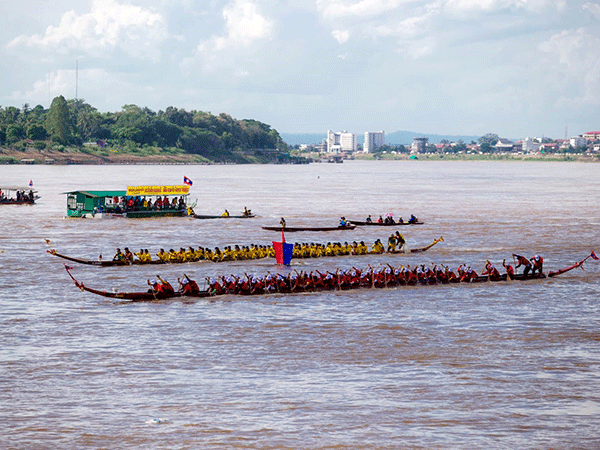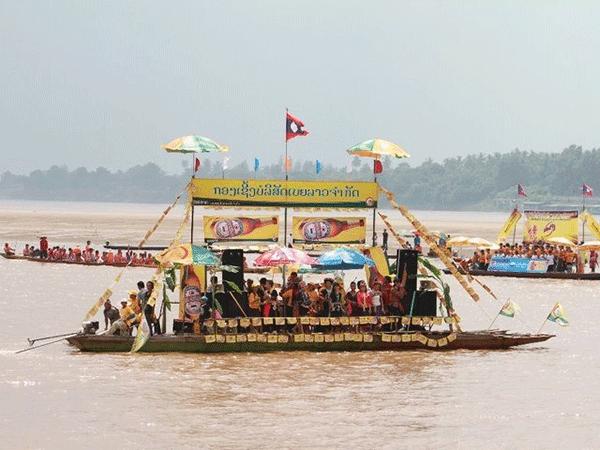Boat races bring towns to life in age-old festival
The Boat Racing Festival in Laos has been enjoyed for hundreds of years and is celebrated on selected days from July to October during Buddhist Lent, when farmers, traders and young people across the country get together in their free time and focus their attention on longboats and rivers.
The boat races and the accompanying festivities (known in Lao as Boun Xuang Heua) take place in many towns across the country, drawing people to riversides to cheer for their favourite racing teams, and bring streets alive with colour, noise, and the smell of cooked food sold at myriad stalls.
 |
| The boat racing festival on the Mekong River in Vientiane. (File photo Phoonsab Thevongsa) |
The word “heua” implies a long wooden boat carved from a single tree trunk, with most long enough to hold about 50 paddlers.
The most popular species of tree for boat-making is “maykhaenheua” (Shorea sp.) and is resistant to both sunlight and rain.
According to Lao Hid 12 Khong sipsi, the boat races have their origins in the tale of Thao Khamphaphinoy.
Lao hid 12 refers to twelves-month traditions that have been passed down through the generations, while the words “khong sipsi” refers to 14 customs that the activity began with long-ago ancestors.
The story of Thao Khamphaphinoy has been around for a long time and recounts the tale of a king (Phaya) whose kingdom was in the locality of Paranasy. The Phaya was greedy and lusted after another man’s wife. The woman was the wife of a Mr Khampha. She was beautiful and was called Khamnga.
She and her husband lived in a small hut. The Phaya ordered Mr Khampha to come to his palace. He placed a bet on a buffalo fight, saying that if Mr Khampha’s buffalo did not win the fight, he would take his wife.
Mr Khampha’s buffalo was defeated but the Phaya made another wager on a cockfight, in which Mr Khampha’s bird was defeated. The Phaya again threatened to take his wife but said they would engage in one more bet.
This time it was a boat race, but the Phaya could have several oarsmen while Mr Khampha would have to paddle his boat by himself.
But when the Phaya’s boat was ahead in the race, it capsized and he drowned.
This incident was interpreted as meaning that if you want to kill someone, you will yourself die.
Former Head of the National Stadium in Vientiane, Mr Khounpheng Khammang, told the Vientiane Times that the Boun Xuang Heua has existed in Laos since time immemorial.
During the three-month Buddhist Lent, each province selects a different date for the Boun Xuang Heua day depending on local customs. In Luang Prabang province, this event is organised to coincide with the Hor Khaopadapdin festival in early September.
 |
| A boat with people cheering for the racing boats on the Mekong River in Vientiane, with traditional music, drums and dances. (File photo Vientiane Times) |
Mr Khounpheng said Vientiane and some other provinces such as Savannakhet and Champassak hold the festival the day after the end of Buddhist Lent.
“No matter where the festival is celebrated, it features the same rituals and activities and is greatly enjoyed by people of all ages,” he said.
It is also the most exciting time of the year for communities living near rivers.
The boat crews start training months in advance, building up their fitness and learning to work as a team, all eagerly anticipating the race day itself.
This event is also a time when traders fill the streets with stalls selling all manner of cheap goods, so it’s a great opportunity for people in search of bargains. And parties abound, with friends and family making the most of the joyful occasion and meeting up in each other’s houses and entertainment venues.
Residents of towns where boat races are held can expect to play host to their neighbours and other visitors, so they prepare special food and drinks, with the noodle dish known as khao poon being particularly popular. When guests arrive, they are usually offered noodles and of course something to drink.
The boat races are a time for entertainment and trade, as well as to display the athletic prowess of the boat crews. In the days before the races, the boats are cleaned and blessed.
When race day comes, the women are first on the river at around 8am and the men’s races follow in the afternoon. In Vientiane, the course runs for two kilometres and the boats assemble at the upstream starting line, competing in pairs to determine which pair will compete in the thrilling final.
The streets are packed with spectators who crowd the riverbanks to watch the spectacle and cheer for their favourite teams.
Whether they are old or young, whether they come with their families or to hang out with their friends, grilled chicken is the food of choice for everyone strolling through the streets, with hundreds of pop up stalls selling the popular snack. It is tasty and filling and can be eaten for breakfast, lunch or dinner.
In most parts of Laos, Boun Suang Heua immediately follows Boun Ork Phansa (the last day of Buddhist Lent). It also heralds the end of the rainy season and is seen as bringing luck to farmers and ensuring an abundant harvest.
By Khonesavanh Latsaphao
(Latest Update September 28, 2022)
|